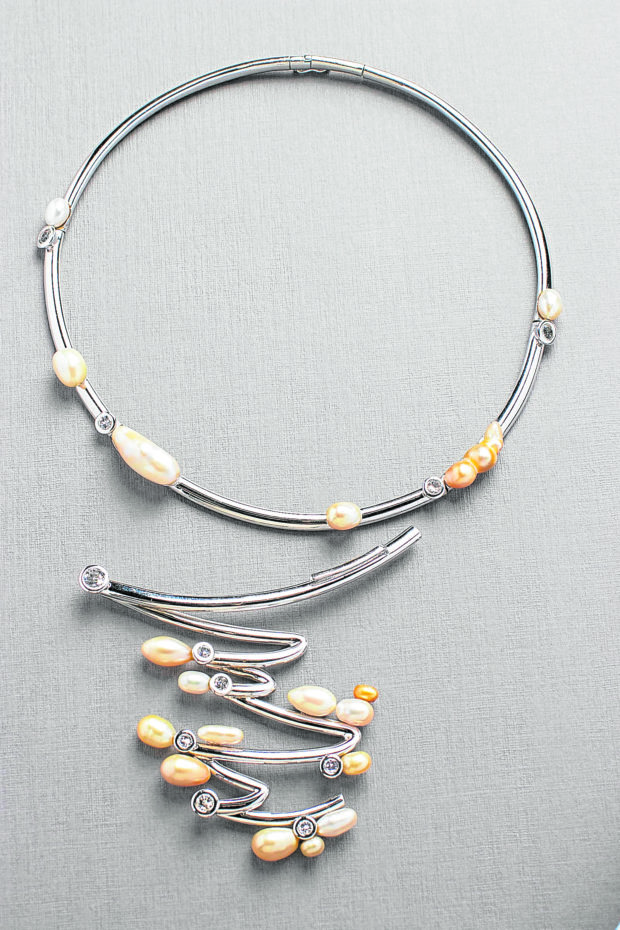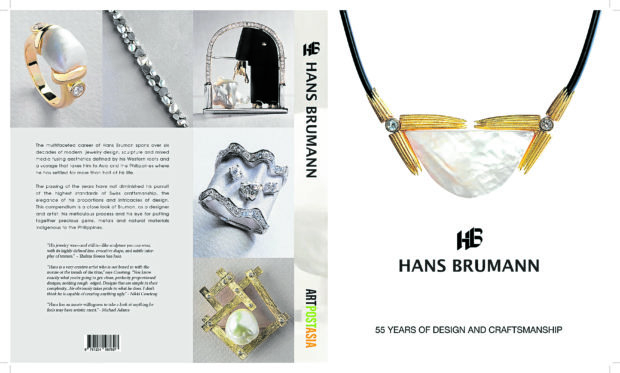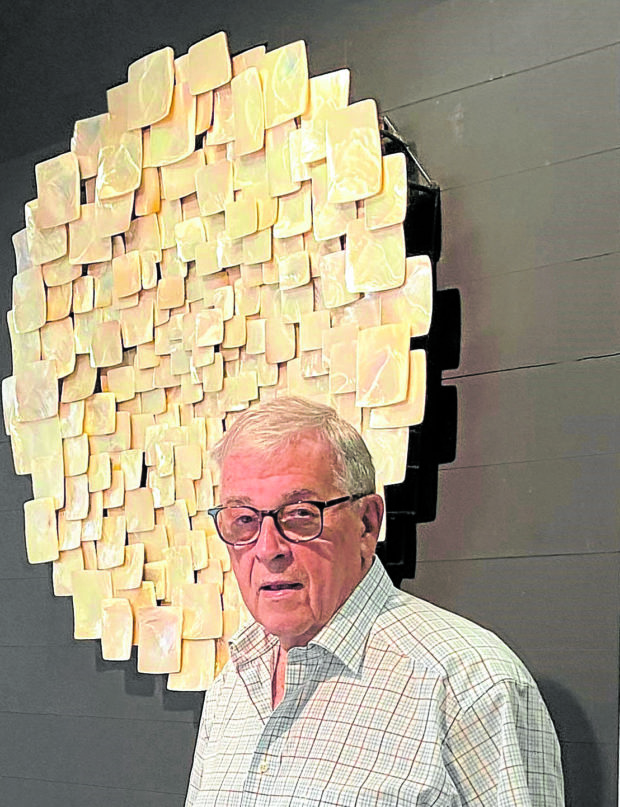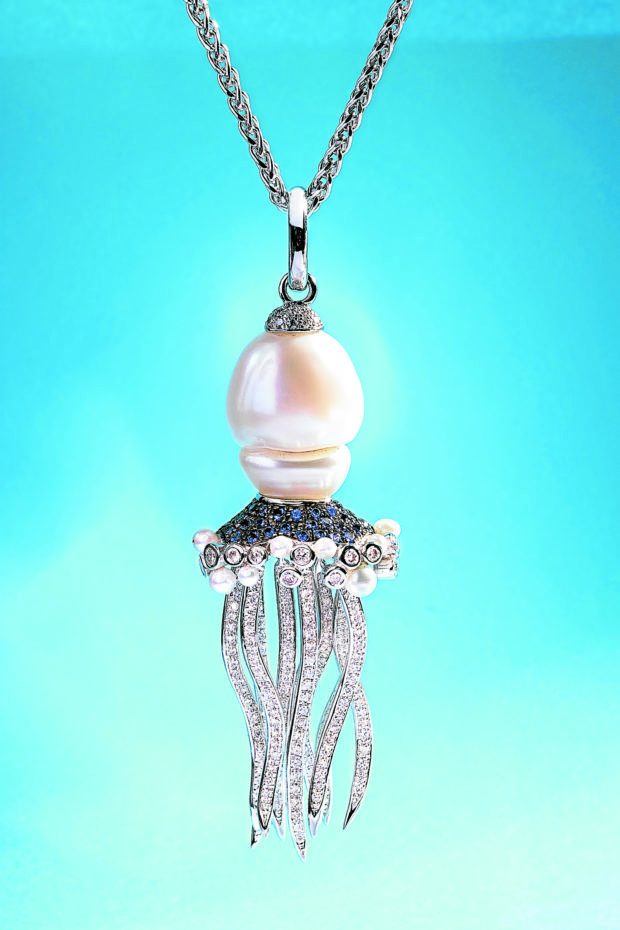The traditional jewelry world felt a jolt of vitality when Hans Brumann launched his namesake brand 47 years ago.
Famous for his inspired panache and flawless execution, the Swiss-turned-Filipino jeweler distinguished himself with his deft use of stones and pearls and contemporary, sculptural designs, which are described in “Hans Brumann: 55 Years of Design and Craftsmanship.”
Brumann marked his 80th birthday last year with this definitive book, which consolidated his works. His namesake brand, founded in 1975, is considered to have created some of the most imaginative and exquisitely jewelry in the country.
“I have been taking photos of my work since I arrived here in the ‘60s, and I ended up with 40 albums. One day, I thought, what would I do with these? It’s better to make a book. When you look at the pieces, you will see the movement from the ’60s up to now. My style hasn’t changed much,” he said.
That style ranges from nature-inspired motifs to abstract, geometric designs that accentuate the precious stones.

Produced by ArtPost Asia and printed in Singapore, the book took three years to make. Flipping through the pages during our interview, he waxed nostalgic over photos of a necklace for Maria, his wife of 52 years; his hometown Bremgarten; his father, Peter, standing outside the family bakery; the blessing of the toddler Hans, his mother Frieda carrying him; and the train that brought him to Zurich for his apprenticeship.
Early days
The son of a baker, Brumann ventured into the jewelry business by becoming an apprentice goldsmith at 16. Studying at a vocational school in Zurich and mastering his chosen calling in different ateliers and a trade school in Germany, Brumann eventually found work with Andrew Grima, the jeweler of the rich and famous, in London.
Grima set an example to never hold back on creativity or daring. Brumann further honed his craft in the workshops of Switzerland’s prominent jewelers.
A magazine advertisement for a goldsmith/designer for La Estrella del Norte, a high-end department store in Manila, brought Brumann to the Philippines in 1967. It specialized in customized jewelry and watchmaking for its affluent clientele.
Barely a month at work as assistant manager and designer, Brumann was tasked by his boss to design three necklaces for First Lady Imelda Marcos’ state visit to Thailand.
Brumann didn’t follow trends. Instead, he concentrated on unorthodox designs that were admired by a discerning clientele.
When La Estrella del Norte changed ownership, he transferred to jewelry retailer Ding Velayo Inc., as vice president for export production. Seeking creative fulfillment, he eventually left to start his own business at home in 1975. He then applied for citizenship in order to start his firm, Hans Brumann Inc.

Brumann’s first office/atelier was located in a building in Greenbelt designed by architect Lorenzo Calma who later collaborated with Brumann on a collection. In 1983, Brumann moved to his present location on Legaspi Street in Makati.
Contrasting stones, stone cuts
The book focuses on Brumann’s exploration of new patterns and subtleties of color, texture and opacity. His work is characterized by juxtapositions of contrasting stones and stone cuts, and clusters of angular lines that create a unique look.
One of his signatures is using the bold geometry of a necklace or a ring that brilliantly emphasizes the magnetic appeal of the diamond or the luster of a pearl.
In his Velvet Moon Collection, Brumann’s mastery lies in the feeling expressed in each piece of jewelry that vividly portrays the unusual forms and glittering colors of the galaxy. Some rings and bracelets are astral patterns of precious gemstones such as blue sapphires, surrounded by sprinklings of diamond.
Defying convention, he introduced new materials such as kamagong (ebony-colored hardwood) and rubber bands. The simple beauty of a kamagong bangle shows off the warmth of Mexican opals.

The concept of high and low fashion is injected in the use of rubber as a necklace with diamonds and mother-of-pearl. “Rubber is strong, durable and cheap. You don’t need to always put expensive items. The rubber helps to shape the neck and it looks good,” explained Brumann.
Unconventional combinations
The book likewise presents unconventional combinations such as diamonds with semiprecious stones and a pendant, made of slabs of beryl, a precious, colorless gemstone, that cradles a blue spinel.
Some of Brumann’s work are in the league of haute joaillerie—a distinctive work of jewelry art or one-of-a-kind creation fashioned from the finest precious materials and assembled with the highest levels of craftsmanship. A stunning example, a splattering of round and baguette-cut Colombian emeralds and white diamonds, interspersed with jagged yellow gold bars, makes for a spontaneous brooch design.
On the other hand, clients who find his abstract designs arcane for their tastes, fancy his whimsical world, which is inhabited by Disney characters that are mostly rendered in baroque pearls. Beetle brooches glimmer with diamond-studded wings. Fruit pendants look yummy in multicolored gemstones. Golden ducks dangle from a bracelet chain, and pearl swans are caught in graceful curves of gold.

There are subjects that resonate with the wearer, such as a brooch of a heart with a pierced nail, or a couple in baroque pearls sitting on a golden bench.
Inspired by the African mask, a pendant is designed with eyes of blue sapphires, wrapped in yellow gold, a citrine Third Eye, a coral nose and cognac-colored diamond lips. A yellow gold ring with pink sapphires is twisted like Danish pastry.
Brumann carries the same discipline of jewelry design to his sculptures—assemblages of exotic hardwoods, mother-of-pearl and black-lip oyster. These are executed as geometric planes, organic shapes and bundles of graceful lines that become shanties, boats and abstract landscapes.
This year, he will create a collection from corundum, the second hardest mineral next to diamonds. Brumann’s business has endured economic downturns and natural calamities. Early in the viral outbreak, the jeweler recovered from a mild case of COVID. For him, the pandemic is just another drill to build resilience. —CONTRIBUTED








































